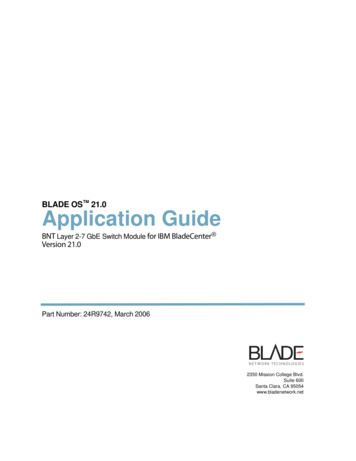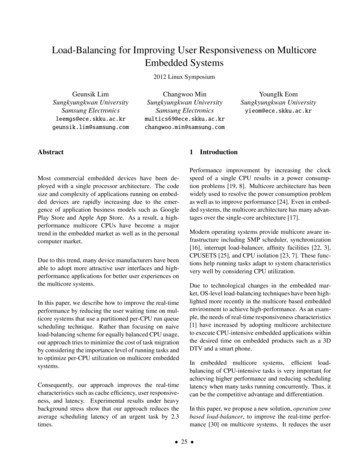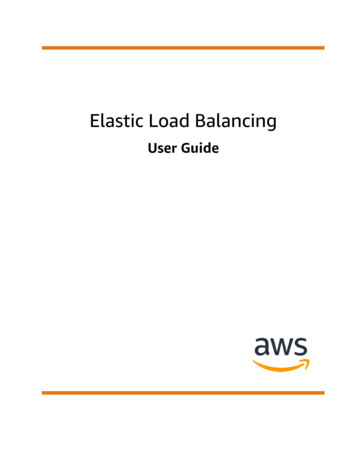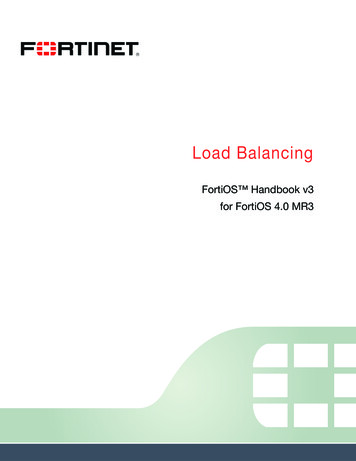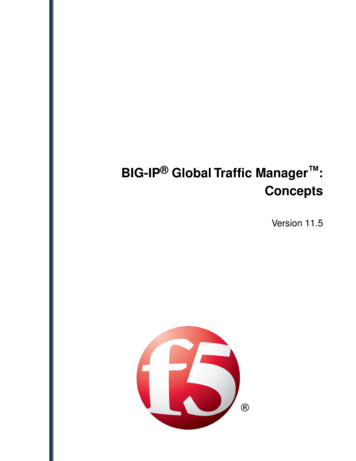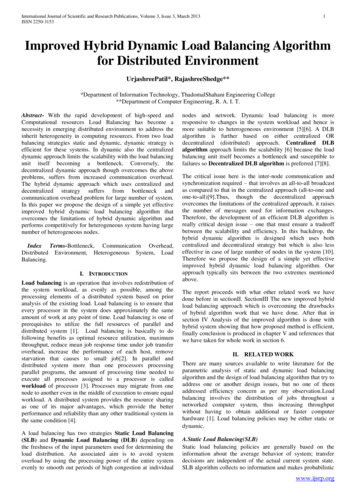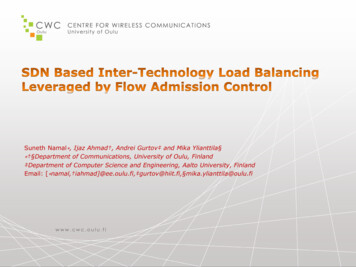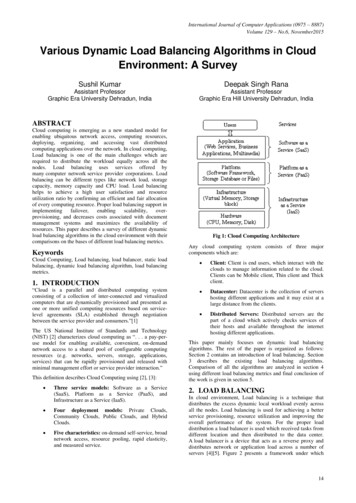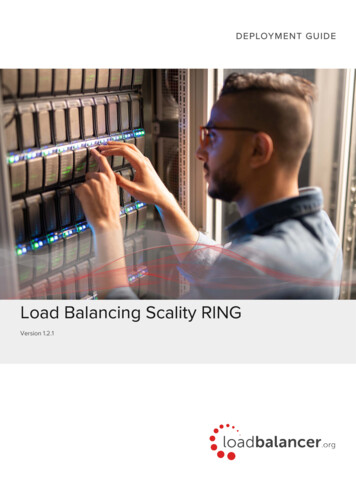
Transcription
Load Balancing Scality RINGVersion 1.2.1
Table of Contents1. About this Guide . . . . . . . . . . . . . . . . . . . . . . . . . . . . . . . . . . . . . . . . . . . . . . . . . . . . . . . . . . . . . . . . . . . . . . . . . . . . . . . . . . . . . 42. Loadbalancer.org Appliances Supported . . . . . . . . . . . . . . . . . . . . . . . . . . . . . . . . . . . . . . . . . . . . . . . . . . . . . . . . . . . . . . . 43. Loadbalancer.org Software Versions Supported . . . . . . . . . . . . . . . . . . . . . . . . . . . . . . . . . . . . . . . . . . . . . . . . . . . . . . . . . 44. Scality RING Software Versions Supported. . . . . . . . . . . . . . . . . . . . . . . . . . . . . . . . . . . . . . . . . . . . . . . . . . . . . . . . . . . . . . 45. Scality RING . . . . . . . . . . . . . . . . . . . . . . . . . . . . . . . . . . . . . . . . . . . . . . . . . . . . . . . . . . . . . . . . . . . . . . . . . . . . . . . . . . . . . . . . 46. Load Balancing Scality RING . . . . . . . . . . . . . . . . . . . . . . . . . . . . . . . . . . . . . . . . . . . . . . . . . . . . . . . . . . . . . . . . . . . . . . . . . . 4Load Balancing & HA Requirements. . . . . . . . . . . . . . . . . . . . . . . . . . . . . . . . . . . . . . . . . . . . . . . . . . . . . . . . . . . . . . . . . . . 4Persistence (aka Server Affinity) . . . . . . . . . . . . . . . . . . . . . . . . . . . . . . . . . . . . . . . . . . . . . . . . . . . . . . . . . . . . . . . . . . . . . . 5Virtual Service (VIP) Requirements . . . . . . . . . . . . . . . . . . . . . . . . . . . . . . . . . . . . . . . . . . . . . . . . . . . . . . . . . . . . . . . . . . . . 5Port Requirements . . . . . . . . . . . . . . . . . . . . . . . . . . . . . . . . . . . . . . . . . . . . . . . . . . . . . . . . . . . . . . . . . . . . . . . . . . . . . . . . . . 5SSL Termination . . . . . . . . . . . . . . . . . . . . . . . . . . . . . . . . . . . . . . . . . . . . . . . . . . . . . . . . . . . . . . . . . . . . . . . . . . . . . . . . . . . . 5Health Checks. . . . . . . . . . . . . . . . . . . . . . . . . . . . . . . . . . . . . . . . . . . . . . . . . . . . . . . . . . . . . . . . . . . . . . . . . . . . . . . . . . . . . . 5GSLB / Location Affinity. . . . . . . . . . . . . . . . . . . . . . . . . . . . . . . . . . . . . . . . . . . . . . . . . . . . . . . . . . . . . . . . . . . . . . . . . . . . . . 5Alternative Load Balancing Method for Read-Intensive Deployments (Direct Routing) . . . . . . . . . . . . . . . . . . . . . . . 57. Performance and Sizing for a Virtual Load Balancer Deployment with Scality RING. . . . . . . . . . . . . . . . . . . . . . . . . . . 58. Deployment Concept . . . . . . . . . . . . . . . . . . . . . . . . . . . . . . . . . . . . . . . . . . . . . . . . . . . . . . . . . . . . . . . . . . . . . . . . . . . . . . . . 69. Loadbalancer.org Appliance – the Basics. . . . . . . . . . . . . . . . . . . . . . . . . . . . . . . . . . . . . . . . . . . . . . . . . . . . . . . . . . . . . . . 6Virtual Appliance . . . . . . . . . . . . . . . . . . . . . . . . . . . . . . . . . . . . . . . . . . . . . . . . . . . . . . . . . . . . . . . . . . . . . . . . . . . . . . . . . . . 6Initial Network Configuration . . . . . . . . . . . . . . . . . . . . . . . . . . . . . . . . . . . . . . . . . . . . . . . . . . . . . . . . . . . . . . . . . . . . . . . . . 7Accessing the WebUI. . . . . . . . . . . . . . . . . . . . . . . . . . . . . . . . . . . . . . . . . . . . . . . . . . . . . . . . . . . . . . . . . . . . . . . . . . . . . . . . 7Main Menu Options . . . . . . . . . . . . . . . . . . . . . . . . . . . . . . . . . . . . . . . . . . . . . . . . . . . . . . . . . . . . . . . . . . . . . . . . . . . . . . 8HA Clustered Pair Configuration . . . . . . . . . . . . . . . . . . . . . . . . . . . . . . . . . . . . . . . . . . . . . . . . . . . . . . . . . . . . . . . . . . . . . . 910. Appliance Configuration for Scality RING . . . . . . . . . . . . . . . . . . . . . . . . . . . . . . . . . . . . . . . . . . . . . . . . . . . . . . . . . . . . . . 9Enabling Multithreaded Load Balancing . . . . . . . . . . . . . . . . . . . . . . . . . . . . . . . . . . . . . . . . . . . . . . . . . . . . . . . . . . . . . . . 911. Appliance Configuration for Scality RING – Using Layer 7 SNAT. . . . . . . . . . . . . . . . . . . . . . . . . . . . . . . . . . . . . . . . . . . 9Configuring VIP 1 – S3 . . . . . . . . . . . . . . . . . . . . . . . . . . . . . . . . . . . . . . . . . . . . . . . . . . . . . . . . . . . . . . . . . . . . . . . . . . . . . . . 9Configuring the Virtual Service (VIP) . . . . . . . . . . . . . . . . . . . . . . . . . . . . . . . . . . . . . . . . . . . . . . . . . . . . . . . . . . . . . . . 10Defining the Real Servers (RIPs) . . . . . . . . . . . . . . . . . . . . . . . . . . . . . . . . . . . . . . . . . . . . . . . . . . . . . . . . . . . . . . . . . . . 1012. Additional Configuration Options & Settings . . . . . . . . . . . . . . . . . . . . . . . . . . . . . . . . . . . . . . . . . . . . . . . . . . . . . . . . . . . 11SSL Termination . . . . . . . . . . . . . . . . . . . . . . . . . . . . . . . . . . . . . . . . . . . . . . . . . . . . . . . . . . . . . . . . . . . . . . . . . . . . . . . . . . . . 11SSL Termination on the load balancer - SSL Offloading . . . . . . . . . . . . . . . . . . . . . . . . . . . . . . . . . . . . . . . . . . . . . . . . . 12Certificates . . . . . . . . . . . . . . . . . . . . . . . . . . . . . . . . . . . . . . . . . . . . . . . . . . . . . . . . . . . . . . . . . . . . . . . . . . . . . . . . . . . . . 12Uploading Certificates . . . . . . . . . . . . . . . . . . . . . . . . . . . . . . . . . . . . . . . . . . . . . . . . . . . . . . . . . . . . . . . . . . . . . . . . . . . 13Configuring SSL Termination on the Load Balancer. . . . . . . . . . . . . . . . . . . . . . . . . . . . . . . . . . . . . . . . . . . . . . . . . . . . . 13Finalizing the Configuration . . . . . . . . . . . . . . . . . . . . . . . . . . . . . . . . . . . . . . . . . . . . . . . . . . . . . . . . . . . . . . . . . . . . . . . . . 1413. Testing & Verification . . . . . . . . . . . . . . . . . . . . . . . . . . . . . . . . . . . . . . . . . . . . . . . . . . . . . . . . . . . . . . . . . . . . . . . . . . . . . . . 15Using System Overview. . . . . . . . . . . . . . . . . . . . . . . . . . . . . . . . . . . . . . . . . . . . . . . . . . . . . . . . . . . . . . . . . . . . . . . . . . . . . 1514. Technical Support. . . . . . . . . . . . . . . . . . . . . . . . . . . . . . . . . . . . . . . . . . . . . . . . . . . . . . . . . . . . . . . . . . . . . . . . . . . . . . . . . . 1515. Further Documentation . . . . . . . . . . . . . . . . . . . . . . . . . . . . . . . . . . . . . . . . . . . . . . . . . . . . . . . . . . . . . . . . . . . . . . . . . . . . . 1516. Conclusion . . . . . . . . . . . . . . . . . . . . . . . . . . . . . . . . . . . . . . . . . . . . . . . . . . . . . . . . . . . . . . . . . . . . . . . . . . . . . . . . . . . . . . . . 1517. Appendix . . . . . . . . . . . . . . . . . . . . . . . . . . . . . . . . . . . . . . . . . . . . . . . . . . . . . . . . . . . . . . . . . . . . . . . . . . . . . . . . . . . . . . . . . 16Configuring GSLB / Location Affinity . . . . . . . . . . . . . . . . . . . . . . . . . . . . . . . . . . . . . . . . . . . . . . . . . . . . . . . . . . . . . . . . . . 16Conceptual Overview. . . . . . . . . . . . . . . . . . . . . . . . . . . . . . . . . . . . . . . . . . . . . . . . . . . . . . . . . . . . . . . . . . . . . . . . . . . . 16DNS Server Prerequisites . . . . . . . . . . . . . . . . . . . . . . . . . . . . . . . . . . . . . . . . . . . . . . . . . . . . . . . . . . . . . . . . . . . . . . . . 17Handling Multiple Subdomains, Including Wildcard Subdomains . . . . . . . . . . . . . . . . . . . . . . . . . . . . . . . . . . . . . . 18Appliance Configuration . . . . . . . . . . . . . . . . . . . . . . . . . . . . . . . . . . . . . . . . . . . . . . . . . . . . . . . . . . . . . . . . . . . . . . . . . 19DNS Server Configuration . . . . . . . . . . . . . . . . . . . . . . . . . . . . . . . . . . . . . . . . . . . . . . . . . . . . . . . . . . . . . . . . . . . . . . . 24Microsoft DNS Server Configuration . . . . . . . . . . . . . . . . . . . . . . . . . . . . . . . . . . . . . . . . . . . . . . . . . . . . . . . . . . . . . . . . . 24Microsoft DNS Server . . . . . . . . . . . . . . . . . . . . . . . . . . . . . . . . . . . . . . . . . . . . . . . . . . . . . . . . . . . . . . . . . . . . . . . . . . . 24
Alternative Load Balancing Method for Read-Intensive Deployments (Direct Routing) . . . . . . . . . . . . . . . . . . . . . . 27Caveats . . . . . . . . . . . . . . . . . . . . . . . . . . . . . . . . . . . . . . . . . . . . . . . . . . . . . . . . . . . . . . . . . . . . . . . . . . . . . . . . . . . . . . . 27Appliance Configuration for Scality RING – Using Layer 4 DR Mode (Direct Routing) . . . . . . . . . . . . . . . . . . . . 28Configuring HA - Adding a Secondary Appliance . . . . . . . . . . . . . . . . . . . . . . . . . . . . . . . . . . . . . . . . . . . . . . . . . . . . . . 2818. Document Revision History . . . . . . . . . . . . . . . . . . . . . . . . . . . . . . . . . . . . . . . . . . . . . . . . . . . . . . . . . . . . . . . . . . . . . . . . . 32
1. About this GuideThis guide details the steps required to configure a load balanced Scality RING environment utilizingLoadbalancer.org appliances. It covers the configuration of the load balancers and also any Scality RINGconfiguration changes that are required to enable load balancing.For more information about initial appliance deployment, network configuration and using the Web User Interface(WebUI), please also refer to the Administration Manual.2. Loadbalancer.org Appliances SupportedAll our products can be used with Scality RING. For full specifications of available models please refer tohttps://www.loadbalancer.org/products. Some features may not be supported in all cloud platforms due to platformspecific limitations, please check with Loadbalancer.org support for further details.3. Loadbalancer.org Software Versions Supported V8.4.1 and laterNoteThe screenshots used throughout this document aim to track the latest Loadbalancer.orgsoftware version. If using an older software version, note that the screenshots presented heremay not match the WebUI exactly.4. Scality RING Software Versions Supported Scality RING – 7.4.4 and later5. Scality RINGScality is a global company that develops software-defined object storage via commercial products such as RING.Scality RING software deploys on industry-standard x86 servers to store objects and files whilst providingcompatibility with the Amazon S3 API.Scality RING architecture supports High Availability (HA) clustering by putting a load balancer in front of it. Loadbalancers monitor and perform health checks on a node to ensure traffic is routed correctly to healthy nodes.Without the use of a load balancer, an off-line or failed node would still receive traffic, causing failures.A variety of load balancing methods are currently supported by Scality RING, dependent on customerinfrastructure, including layer 4, layer 7, and geo GSLB / location affinity. The RING service that should be loadbalanced is the S3 component.6. Load Balancing Scality RINGNoteIt’s highly recommended that you have a working Scality RING environment first beforeimplementing the load balancer.Load Balancing & HA RequirementsThe function of the load balancer is to distribute inbound connections across a cluster of Scality RING nodes, toprovide a highly available and scalable service. One virtual service is used to load balance the S3 aspect of RING. Copyright Loadbalancer.org Documentation Load Balancing Scality RING4
Persistence (aka Server Affinity)Client persistence is not required and should not be enabled.Virtual Service (VIP) RequirementsTo provide load balancing for Scality the following VIP is required: S3: handles requests from S3 client applications via HTTP and HTTPSPort RequirementsThe following table shows the ports that are load balanced:PortProtocolsUse80TCP/HTTPRequests from S3 client applications443TCP/HTTPSRequests from S3 client applicationsSSL TerminationSSL termination on the load balancer is recommended for load balancing Scality RING.Health ChecksThe S3 service uses the "Negotiate HTTP (GET)" health check.GSLB / Location AffinityFor multi-site RING deployments, it is possible to use the load balancer’s GSLB functionality to provide highavailability and location affinity across multiple sites. Using this optional, DNS based feature, in the event that asite’s RING service and/or load balancers are offline then local clients are automatically directed to a functioningRING cluster at another site.A full explanation and instructions on setting up this optional feature can be found in Configuring GSLB / LocationAffinity.Alternative Load Balancing Method for Read-Intensive Deployments (Direct Routing)For deployments that are read-intensive, it is possible to use an alternative load balancing method known as DirectRouting. This allows reply traffic to flow directly from the back end servers to the clients, thus removing the loadbalancer as a potential bottleneck for reply traffic. Direct routing can benefit read-intensive deployments with alarge reply traffic to request traffic ratio.A more detailed explanation of this alternative load balancing method can be found in Alternative Load BalancingMethod for Read-Intensive Deployments (Direct Routing).7. Performance and Sizing for a Virtual Load Balancer Deployment withScality RINGThe Loadbalancer.org appliance can be deployed as a Virtual Appliance.To achieve the best level of performance and throughput when load balancing a Scality RING deployment, theLoadbalancer.org appliance should be configured to actively use multiple CPU cores for the load balancing Copyright Loadbalancer.org Documentation Load Balancing Scality RING5
process. This must be considered when initially deploying and sizing virtual appliances.A virtual host should be allocated a minimum of 4 vCPUs.8. Deployment ConceptVIPs Virtual IP AddressesNOTE: The load balancer can be deployed as a single unit, although Loadbalancer.org recommends a clusteredpair for resilience & high availability. Please refer to Configuring HA - Adding a Secondary Appliance for moredetails on configuring a clustered pair.9. Loadbalancer.org Appliance – the BasicsVirtual ApplianceA fully featured, fully supported 30 day trial is available if you are conducting a PoC (Proof of Concept) deployment.The VA is currently available for VMware, Virtual Box, Hyper-V, KVM, XEN and Nutanix AHV and has beenoptimized for each Hypervisor. By default, the VA is allocated 2 vCPUs, 4GB of RAM and has a 20GB virtual disk.The Virtual Appliance can be downloaded here.NoteThe same download is used for the licensed product, the only difference is that a license key file(supplied by our sales team when the product is purchased) must be applied using theappliance’s WebUI.NotePlease refer to The Virtual Appliance - Hypervisor Deployment and the ReadMe.txt text fileincluded in the VA download for more detailed information on deploying the VA using variousHypervisors.NoteFor the VA, 4 NICs are included but only eth0 is connected by default at power up. If the otherNICs are required, these should be connected using the network configuration screen within theHypervisor. Copyright Loadbalancer.org Documentation Load Balancing Scality RING6
Initial Network ConfigurationAfter boot up, follow the instructions on the console to configure the IP address, subnet mask, default gateway,DNS and other network settings.ImportantBe sure to set a secure password for the load balancer, when prompted during the setuproutine.Accessing the WebUIThe WebUI is accessed using a web browser. By default, user authentication is based on local Apache .htaccessfiles. User administration tasks such as adding users and changing passwords can be performed using the WebUImenu option: Maintenance Passwords.NoteA number of compatibility issues have been found with various versions of Internet Explorer andEdge. The WebUI has been tested and verified using both Chrome & Firefox.NoteIf required, users can also be authenticated against LDAP, LDAPS, Active Directory or Radius. Formore information please refer to External Authentication.1. Using a browser, access the WebUI using the following URL:https:// IP-address-configured-during-network-setup-wizard :9443/lbadmin/2. Log in to the WebUI:Username: loadbalancerPassword: configured-during-network-setup-wizard NoteTo change the password, use the WebUI menu option: Maintenance Passwords.Once logged in, the WebUI will be displayed as shown below: Copyright Loadbalancer.org Documentation Load Balancing Scality RING7
NoteThe WebUI for the VA is shown, the hardware and cloud appliances are very similar. Theyellow licensing related message is platform & model dependent.3. You’ll be asked if you want to run the Setup Wizard. If you click Accept the Layer 7 Virtual Serviceconfiguration wizard will start. If you want to configure the appliance manually, simple click Dismiss.Main Menu OptionsSystem Overview - Displays a graphical summary of all VIPs, RIPs and key appliance statisticsLocal Configuration - Configure local host settings such as IP address, DNS, system time etc.Cluster Configuration - Configure load balanced services such as VIPs & RIPsMaintenance - Perform maintenance tasks such as service restarts and taking backupsView Configuration - Display the saved appliance configuration settingsReports - View various appliance reports & graphs Copyright Loadbalancer.org Documentation Load Balancing Scality RING8
Logs - View various appliance logsSupport - Create a support download, contact the support team & access useful linksLive Chat - Start a live chat session with one of our Support EngineersHA Clustered Pair ConfigurationLoadbalancer.org recommend that load balancer appliances are deployed in pairs for high availability. In this guidea single unit is deployed first, adding a secondary unit is covered in Configuring HA - Adding a SecondaryAppliance.10. Appliance Configuration for Scality RINGEnabling Multithreaded Load BalancingMultithreading is enabled by default for new load balancers starting from version 8.5.1 and doesnot require changing.NoteIf upgrading an older appliance then ensure that the multithreading configuration is set correctly,as described below.The Loadbalancer.org appliance should be configured to actively use multiple CPU cores for the load balancingprocess. This is required to achieve the high level of performance and throughput required when load balancing aScality RING deployment.NoteA virtual host should be allocated a minimum of 4 vCPUs.A minimum of 4 threads should be defined. The number of threads can be set as high as the number of threadsavailable to the system (setting the value even higher than that will not increase performance).To enable multithreaded mode from the WebUI:1. Navigate to Cluster Configuration Layer 7 - Advanced Configuration.2. Check the Enable Multithreading checkbox.3. Set Number of Threads to a minimum of 4.4. Click Update to apply the changes.11. Appliance Configuration for Scality RING – Using Layer 7 SNATConfiguring VIP 1 – S3 Copyright Loadbalancer.org Documentation Load Balancing Scality RING9
Configuring the Virtual Service (VIP)1. Using the web user interface, navigate to Cluster Configuration Layer 7 – Virtual Services and click on Add anew Virtual Service.2. Define the Label for the virtual service as required, e.g. S3.3. Set the Virtual Service IP Address field to the required IP address, e.g. 172.16.254.120.4. Set the Ports field to 80.5. Set the Layer 7 Protocol to HTTP Mode.6. Click Update to create the virtual service.7. Click Modify next to the newly created VIP.8. Set Persistence Mode to None.9. Set Health Checks to Negotiate HTTP (GET).10. Set Request to send to / /healthcheck/deep/.11. Scroll to the Other section and click Advanced.12. Enable Force to HTTPS by clicking the Yes radio button.13. Click Update.Defining the Real Servers (RIPs)1. Using the web user interface, navigate to Cluster Configuration Layer 7 – Real Servers and click on Add anew Real Server next to the newly created VIP.2. Define the Label for the real server as required, e.g. ring-node1.3. Set the Real Server IP Address field to the required IP address, e.g. 172.16.254.101. Copyright Loadbalancer.org Documentation Load Balancing Scality RING10
4. Click Update.5. Repeat these steps to add additional RING nodes as real servers as required.12. Additional Configuration Options & SettingsSSL TerminationSSL termination can be handled in the following ways:1. On the Real Servers - aka SSL Pass-through.2. On the load balancer – aka SSL Offloading (recommend for Scality RING).3. On the load balancer with re-encryption to the backend servers – aka SSL Bridging.In the case of Scality RING, it is recommended that SSL be terminated on the load balancer (SSL offloading) withForce to HTTPS enabled.Notes1. SSL termination on the load balancer can be very CPU intensive.2. By default, a self-signed certificate is used for the new SSL VIP. Certificates can be requested on the loadbalancer or uploaded as described in the section below. The default self-signed certificate can beregenerated if needed using the WebUI menu option: SSL Certificate and clicking the Regenerate Default SelfSigned Certificate button.3. The backend for the SSL VIP can be either a Layer 7 SNAT mode VIP or a Layer 4 NAT or SNAT mode VIP.Layer 4 DR mode cannot be used since stunnel acts as a proxy, and the RING servers see requests with asource IP address of the VIP. However, since the RING servers believe that they own the VIP (due to theloopback adapter configured to handle to ARP problem) they are unable to reply to stunnel.4. Finally, ensure that the Scality RING S3 Console and S3 Browser URL are configured as HTTPS via the S3Service as per the example image below: Copyright Loadbalancer.org Documentation Load Balancing Scality RING11
SSL Termination on the load balancer - SSL OffloadingIn this case, an SSL VIP utilizing STunnel is configured on the appliance and an SSL certificate is uploaded andassociated to the Virtual Service. Data is encrypted from the client to the load balancer, but is unencrypted from theload balancer to the backend servers as shown above.CertificatesIf you already have an SSL certificate in either PFX or PEM file format, this can be uploaded to the Load balancerusing the certificate upload option as explained in Uploading Certificates. Alternatively, you can create a CertificateSigning Request (CSR) on the load balancer and send this to your CA to create a new certificate. For moreinformation please refer to Generating a CSR on the Load Balancer. Copyright Loadbalancer.org Documentation Load Balancing Scality RING12
Uploading CertificatesIf you already have a certificate in either PEM or PFX format, this can be uploaded to the load balancer.To upload a Certificate:1. Using the WebUI, navigate to: Cluster Configuration SSL Certificates.2. Click Add a new SSL Certificate & select Upload prepared PEM/PFX file.3. Enter a suitable Label (name) for the certificate, e.g. Cert1.4. Browse to and select the certificate file to upload (PEM or PFX format).5. Enter the password , if applicable.6. Click Upload Certificate, if successful, a message similar to the following will be displayed:NoteIt’s important to backup all your certificates. This can be done via the WebUI from Maintenance Backup & Restore Download SSL Certificates.Configuring SSL Termination on the Load Balancer1. Using the WebUI, navigate to: Cluster Configuration SSL Termination and click Add a new Virtual Service. Copyright Loadbalancer.org Documentation Load Balancing Scality RING13
2. Using the Associated Virtual Service drop-down, select the Virtual Service created above, e.g. S3.NoteOnce the VIP is selected, the Label field will be auto-populated with SSL-S3. This can bechanged if preferred.NoteThe Associated Virtual Service drop-down is populated with all single port, standard (i.e.non-manual) Layer 7 VIPs available on the load balancer. Using a Layer 7 VIP for thebackend is the recommended method although as mentioned earlier, Layer 4 NAT modeand layer 4 SNAT mode VIPs can also be used if required. To forward traffic from the SSLVIP to these type of VIPs, you’ll need to set Associated Virtual Service to Custom, thenconfigure the IP address & port of the required VIP.3. Leave Virtual Service Port set to 443.4. Leave SSL Operation Mode set to High Security.5. Select the required certificate from the SSL Certificate drop-down.6. Click Update.Once configured, HTTP traffic will be load balanced by the Layer 7 SNAT mode VIP and HTTPS traffic will beterminated by the SSL VIP, then passed on to the Layer 7 SNAT mode VIP as unencrypted HTTP for load balancing.Finalizing the ConfigurationTo apply the new settings, HAProxy and STunnel must both be reloaded. This can be done using the buttons in theblue box at the top of the screen or by using the Restart Services menu option:1. Using the WebUI, navigate to: Maintenance Restart Services.2. Click Reload HAProxy.3. Click Reload STunnel. Copyright Loadbalancer.org Documentation Load Balancing Scality RING14
13. Testing & VerificationNoteFor additional general guidance please also refer to Testing Load Balanced Services.Using System OverviewThe System Overview can be viewed in the WebUI. It shows a graphical view of all VIPs & RIPs (i.e. the RINGNodes) and shows the state/health of each server as well as the state of the each cluster as a whole. The examplebelow shows that all RING nodes are healthy and available to accept connections.14. Technical SupportFor more details about configuring the appliance and assistance with designing your deployment please don’thesitate to contact the support team using the following email address: support@loadbalancer.org.15. Further DocumentationThe Administration Manual contains much more information about configuring and deploying the appliance. It’savailable here: rationv8.pdf.16. ConclusionLoadbalancer.org appliances provide a very cost effective solution for highly available load balanced Scality RINGenvironments. Copyright Loadbalancer.org Documentation Load Balancing Scality RING15
17. AppendixConfiguring GSLB / Location AffinityConceptual OverviewFor multi-site RING deployments, it is possible to use the load balancer’s global server load balancing (GSLB)functionality to provide both high availability and location affinity across multiple sites. Clients across multiple sites use the same fully qualified domain name to access RING services. Under normal operation: clients are directed to their local site’s RING cluster. In the event of a local service failure: clients are automatically directed to a functioning RING cluster atanother site. This would happen if the local site’s RING service and/or load balancers were offline andunavailable.For the sake of simplicity, the diagram presented below shows a two site setup. The principle can be extended toencompass as many sites as desired.Explanation: Start: A client tries to access the RING service using the S3 protocol. To do this, the client uses the service’sfully qualified domain name, in this example gslb.domain.tldThe client sends a DNS query for gslb.domain.tld to its local DNS server. Copyright Loadbalancer.org Documentation Load Balancing Scality RING16
The DNS server has the domain gslb.domain.tld delegated to the load balancers. The DNS server sends a delegated DNS query for gslb.domain.tld to one of the load balancers. The load balancer that received the delegated DNS query replies to the DNS server. The load balanceranswers with the IP address of the VIP (RING instance) that is local to the DNS server making the query, andhence local to the original client. An example: if the delegated query from the DNS server originated from the 10.0.0.0/24 subnet then theVIP in that subnet is served up. Likewise, if the delegated query originated from the 172.16.0.0/24 subnetthen the VIP in that subnet is served up. As such, clients are always directed to their local, on-site RINGinstance, provided that the local instance is online and available. The DNS server sends the delegated DNS answer to the client. Finish: The client connects to the S3 service at gslb.domain.tld by using the local VIP address.In the event that the cluster of RING cluster and/or load balancers at one site should completelyfail then local clients will be directed to the RING cluster at the other site and the service willcontinue to be available.NoteThis style of multi-site failover is possible because the load balancers' GSLB functionalitycontinuously health checks the service at each site. When the service at a site is observed to beunavailable then that site’s IP address is no longer served when responding to DNS queries.DNS Server PrerequisitesImportantLocation affinity (ensuring clients 'stick' to their local site) requires a unique DNS server ateach site.For this setup to work and provide location affinity, a unique DNS server is required at each site, like the exampledeployment shown at the beginning of this section.If multiple sites share a common DNS server then clients cannot be directed to their local, on-site RING instance.Example: Consider a two data centre deployment with a shared, common DNS server located at DC 1. From theperspective of a load balancer in this scenario, every delegated DNS request would be seen to come from thesingle, shared DNS server at DC 1. Specifically, the requests
SSL termination on the load balancer is recommended for load balancing Scality RING. Health Checks The S3 service uses the "Negotiate HTTP (GET)" health check. GSLB / Location Affinity For multi-site RING deployments, it is possible to use the load balancer's GSLB functionality to provide high availability and location affinity across .
